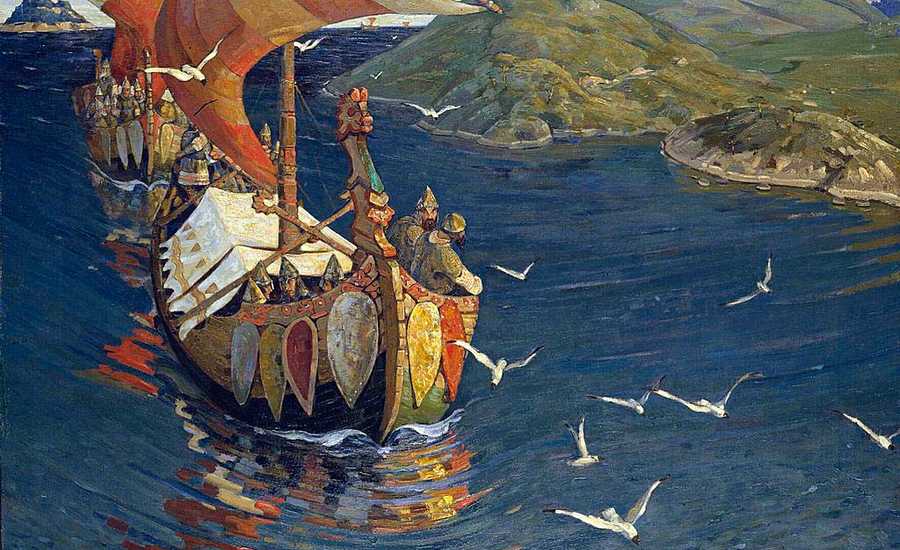Kievian Russia
How did Russia become a country?
- In 882, a Viking prince named Oleg seized power in Kiev, which he then proclaimed the “mother of Russian cities”. In doing so, he unified the Slav dwellings scattered across a vast area that would then become known as the “Kievan Rus’”.
- Oleg established friendly relations with the nearby Byzantium Empire and defeated everyone who threatened his rule.
- The first Slavic royal to adopt the Christian religion was Olga. She was baptized in 957.
- In an attempt to consolidate his citizens, Olga’s grandson, Vladimir, introduced Christianity to the Kievan Rus’ between 988 and 990 — after discarding Islam and Judaism as unsuitable for his country.
- During the reign of prince Iaroslav from 1019 to 1054, the Kievan Rus’ reached its zenith. It stretched from the Baltic Sea in the North to the Black Sea in the South, the Oka River in the East and the Carpathian Mountains in the West. Under his rule, education, architecture and art thrived. He also loosened Byzantium’s tight grip on Russian religious affairs by appointing his own bishops and introducing the first Slavic saints — Boris and Gleb, who had died as martyrs during the civil war of 1015 - 1019. He also established the first Russian legal code: the Russian Justice.
- After Iaroslav’s death, the Rus’ suffered many civil wars and invasions until the Mongols finally took over the land in 1240.
The history of the first Russian state, that of Kiev, is semi-legendary and therefore resembles a fairy-tale, much like the ones grandmothers often tell children to make them fall asleep. Yet the early history of Russia also resembles a mysterious detective story, because sources on the topic aren't plentiful and therefore we don't know much about it. Although it's difficult and even impossible to produce all the correct answers, we can at least be able to avoid the cruder mistakes and oversimplifications.
The Establishment of the Kievian State
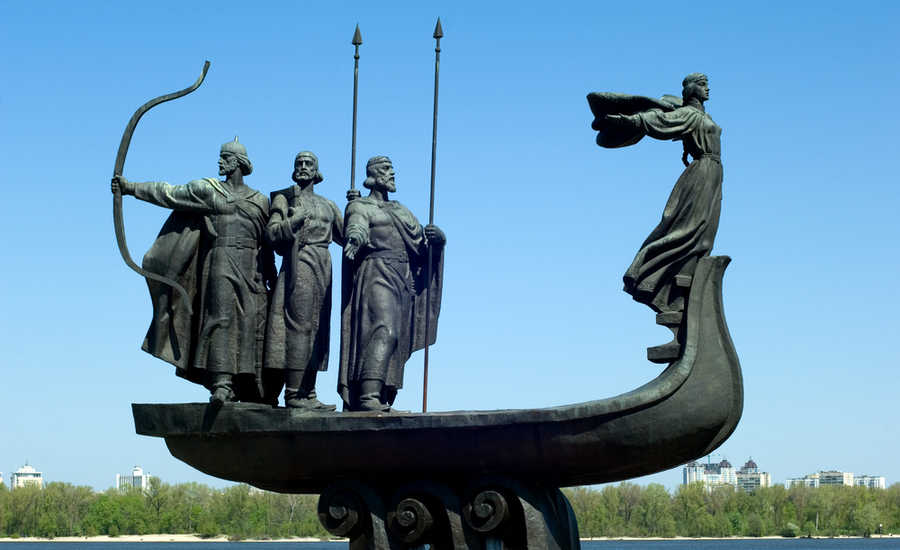
In the 12th century Russia was one of Europe's most culturally- and economically-developed countries, admired by many of its neighbors. It was at this time that Nestor, a monk of the Kievian monastery, finished the work of his life - the Primary Chronicle. This historical composition is a thrilling read and full of adventure, yet it is also rightly considered one of the main sources regarding early Russian history. The Primary Chronicle begins with the following questions: "What is the origin of the Russian land?" and "Who was the first to become the prince of Kiev?" These questions are vitally important even today. The first one is clear, for Russian land is a territory, a people and a state as well, and a state in the minds of medieval people was closely connected with its ruler. The Chronicle also successfully illustrated Russian history in movement. Authors of the latter Chronicles inevitably began their compositions by researching the Primary Chronicle. For these reasons the Primary Chronicle is considered to be the main source of information about the period of Kievian Russia's establishment.
Russian lands had a profitable geographical position - lying at the crossroads of Christian and Moslem worlds they had a significant impact on cultural, economic and political world development. The trade route "from the Varangian to the Greek" was of special importance. It connected the Baltic Sea with the Black Sea and thus enabled the commercial relations between northern Europe and the Byzantine Empire to develop. This commercial route went through such rivers as the Neva, the Volkhov, and the Dniepr, which were situated in the areas inhabited by the East Slavs. Of course, the East Slavs profited from the geographical position of their territories. They were establishing cities which soon grew into flourishing commercial, political and cultural centers. Kiev in the South and Novgorod in the North were the largest and the most influential of them all, and it was no surprise that they were absorbing the East Slavs living in nearby territories. Generally speaking, Novgorod and Kiev had played an important role in laying a foundation for the future Russian state. According to the Primary Chronicle, Kiev was established by the legendary Slavic prince Kiy in approximately the 7th century A.D.
The East Slavs, who were on the way to establish a state of their own, had rather dangerous and powerful neighbors. The Khazars living at the mouth of the Volga forced some southern Slavic tribes (including the Polaine) to pay them a tribute. At the same time the northern territories - located around Novgorod - were often raided by the warlike Vikings, who were pirates from Scandinavia and extremely feared in Europe. According to the Primary Chronicle, in the middle of the 9th century the Vikings made the East Slavs in the North and some Finnish tribes pay them a huge tax. How and when exactly they managed to do so, none of the scholars can say for sure. But the Vikings' rule didn't last long - the Slavs and the Finns came together and drove them out of their land. But on having won their independence, they failed to live peacefully with each other and therefore sent ambassadors to the Vikings. The ambassadors said to them: "Our whole land is great and rich but there is no order in it. Come to rule and reign over us".
The First Russian Prince
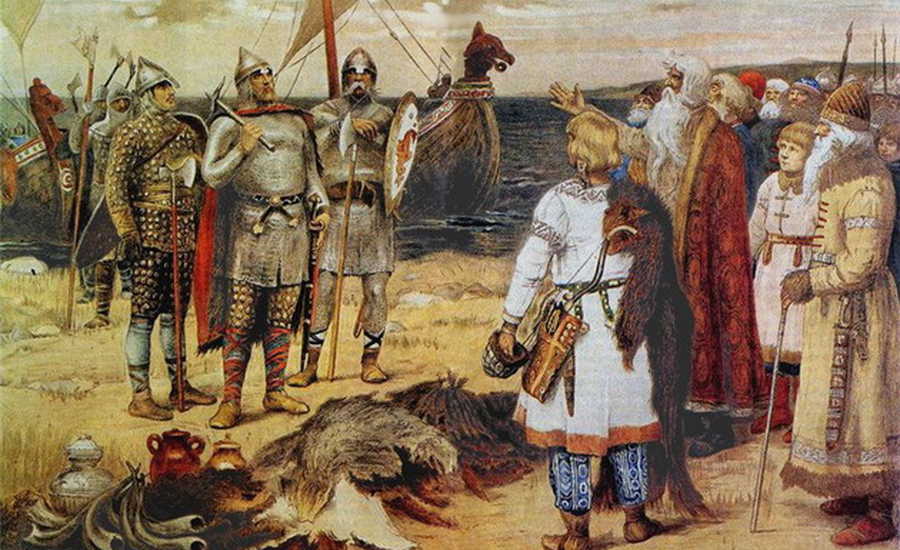
Three Varangians (the Vikings were known among the East Slavs under this name) accepted the invitation. They were three brothers Rurik, Sineus and Truvor. The oldest, Rurik, located himself in Novgorod; the second, Sineus, in Byeloozero; and the third, Truvor, in Izborsk. According to the Primary Chronicle, "the district of Novgorod became known as the land of the Rus. The present inhabitants of Novgorod are descended from the Varangian race, but with time they were Slavs". In the proceeding two centuries Sineus and Truvor died, leaving Rurik to rule the northern Slavic territories alone. One day two of his retainers, Askold and Dir, came to him and asked for permission to go to Constantinople, then started their journey by ship. They arrived in Kiev, another center for East Slavs, managed to seize power, and decided to stay there. As for Rurik, he ruled in Novgorod until his death in 879. His son Igor was too young to rule, so instead Oleg, a close relative, gained all power in the northern Slavic areas. So it was Rurik who managed to establish the first dynasty of Russian princes, and Oleg succeeded him.
Thus it was the Vikings who established the first Russian dynasty of princes. More than that, the words "Russia" and "Russian", strange though it may seem, are probably of Norman origin. Some historians believe that the southern coast of Sweden from which Rurik came from was known as Ruslagen. That's why the author of the Primary Chronicle called the people living there the Ruses. But there are some historians who claim that the word "Russia" first appeared in the South, where the Ros River flows. According to some Byzantine and Arabic sources, the word "Russia" already existed before the Viking arrival in 862. It is impossible to say for sure how, when, and where the words "Russia" and "Russian" came from.
Returning to the story of the princes: Oleg put his Slavic, Viking and Finnish forces together and with a large army headed for Kiev. He proved himself to be not only a skillful warrior, but also a cunning man. Having arrived in Kiev, he ordered his men to hide under the boat and then told the town-dwellers that he was a merchant. When Askold and Dir, the Kievian rulers, came out to greet him, Oleg's warriors suddenly appeared and killed them. As for Oleg, he managed to seize power in Kiev, which he proclaimed the mother of Russian cities. Thus he managed to integrate northern and southern centers of East Slavic culture and establish a state. 882 is considered to be the year when Kievian Russia was born.
The Rise of the Kievian State
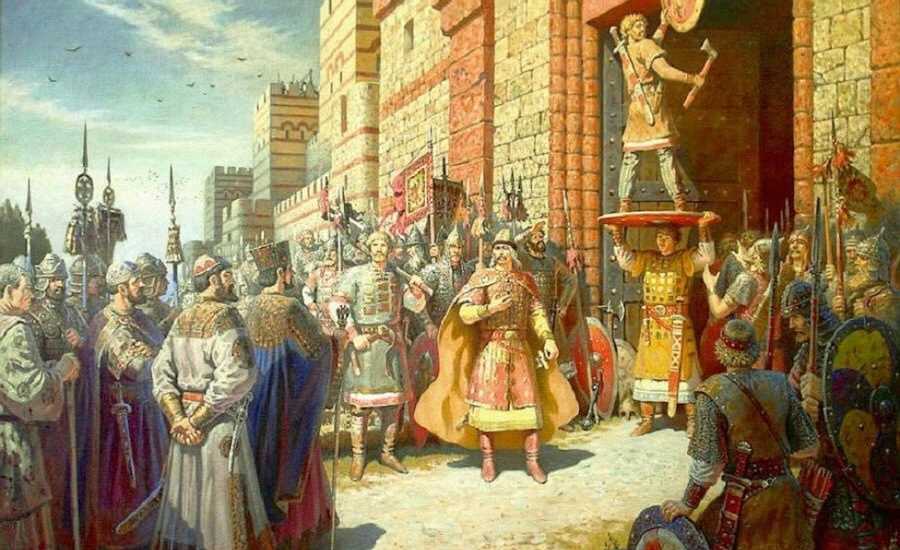
According to the Primary Chronicle, between 882 and 912 Oleg was an effective ruler of the first Russian State, Kiev. His goals were to gain authority over the independent tribes of East Slavs, to fight against nomads and other exterior enemies, and to establish good commercial relations with neighboring superpowers, mainly the Byzantine Empire. By the end of his rule, Oleg's authority extended over the areas of the Poliane (around Kiev), Sloviane (around Novgorod), Drevliane, Severiane, Radimichi, Krivichi and some Finnish tribes. Even at that time Russia was one of the largest countries in Europe.
To protect his vast possessions, Oleg started developing towns in the southeastern frontier. The Khazars had used to raid Russia from there, but Oleg defeated them several times and for some period of time Russia was out of danger. Toward the end of his life Oleg became a statesman of international importance. He gathered a sufficient army by 907 and had a successful campaign against Byzantium. According to Primary Chronicle the citizens of Constantinople were not expecting Oleg or his brute force to invade so strongly and so soon. The campaign resulted in an exceptionally advantageous trade treaty, signed a bit later, in the year 911. According to the treaty, Russian merchants obtained the right of free trade, of living for some time at the government's expense in Constantinople and even to wash in the city's bathhouses (it was always considered to be a privilege only granted to high-class representatives). But merchants were not to live in the city without written permission or to walk on its streets wearing a weapon.
Oleg has gone down in history as one of the best Kievian princes. A ruler of local importance, he managed to make a big unified state out of numerous split lands and to gain the country's international recognition. He defeated rebellious East Slavic and Finnish tribes, the powerful Khazars and finally the mighty Byzantines. "And Oleg became known as prophetic" - with these words the author of the Primary Chronicle ends his narration about him.
Prince Igor
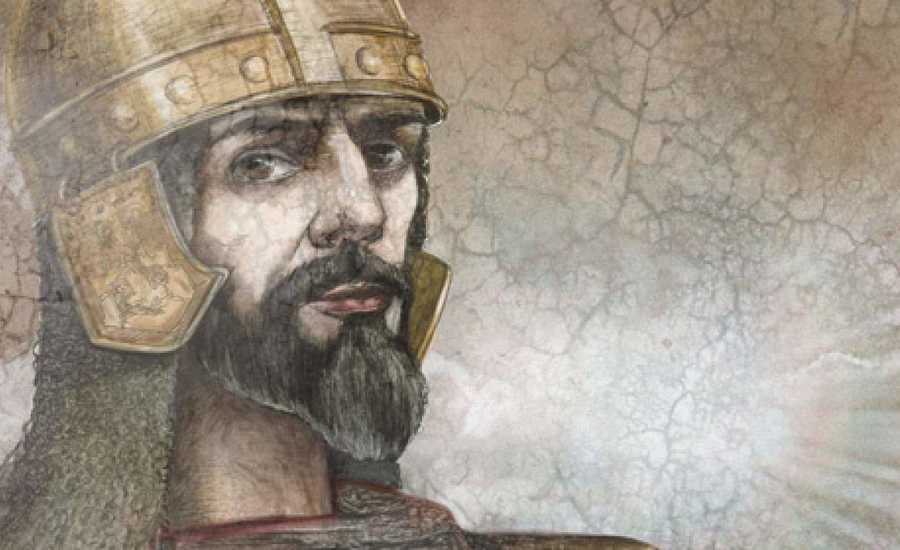
Oleg's successor, prince Igor, ruled Kievian Russia from 913 until his death in 945. Our knowledge of him comes from Greek and Latin, in addition to Russian, sources. Igor had to fight the Drevliane as well as to maintain and spread Kievian authority in other East Slavic lands. As already mentioned, that authority remained rather precarious, so that each new prince was forced to repeat in large part the work of his predecessor. As Oleg had done, Igor had to fight the nomads, raiding Kievian Russia from the steppe. Since the year 915, The Pechenegs had become the most dangerous of them all. They prevailed near the Russian border for a little more than a century, until 1054, when the Polovtsi first appeared. A constant war against Nomadic peoples was a negative factor absolutely unknown in Europe.
Under Igor's rule the relations with Byzantium started to worsen gradually, because the imperial government didn't accomplish the peace terms of 911. That's why in 941 Igor engaged a major campaign against Constantinople and devastated its suburbs. But his fleet was defeated by the Byzantine navy, which used the celebrated "Greek fire". ("The Greek fire" was an incendiary compound projected through copper pipes by Byzantine sailors to set the ships of their opponents on fire. Its exact composition remains unknown even to the present day.) In 944 Igor organized another campaign against Byzantium and this time the Russians were more fortunate. On having heard how powerful and plentiful Russian troops were, the Emperor decided to send an ambassador to negotiate with them. Igor decided to take a huge contribution and leave for Kiev. The war was finally over with the treaty of 944, the provisions of which were rather less favorable to the Russians than those of the preceding, 911 agreement.
Nevertheless death was waiting for Igor not abroad, but at home, in Russia. According to the Primary Chronicle, in the year 945 Igor went with his warriors to the land of the Drevliane to collect tribute. The Prince made it seem like he had collected enough money, but with some of his closest friends he decided to collect some more tribute in the town of Iskorosten. The Drevliane decided to kill the Kievian prince. "If a wolf starts eating sheep, he will exterminate the whole herd, unless he is killed". So, because of his greediness, Igor died in 945.
Olga's Revenge
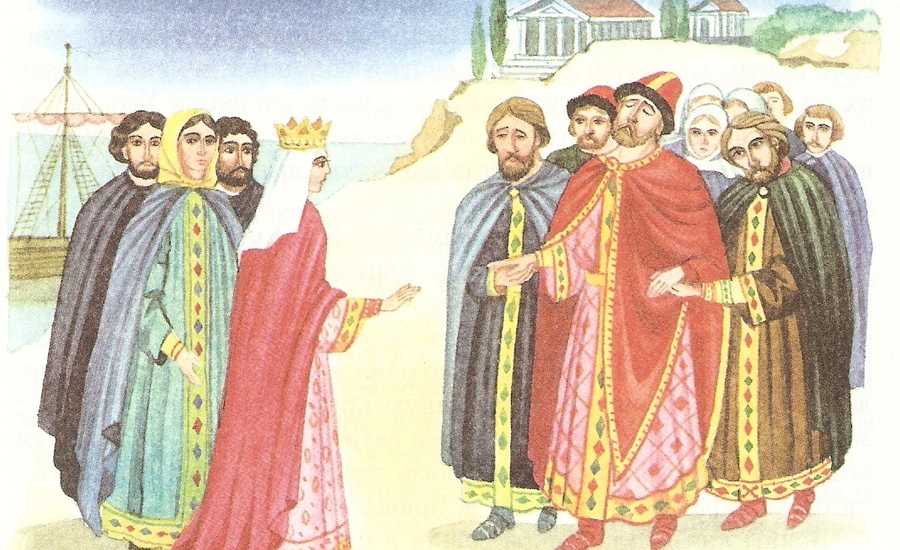
Igor's sudden death left his widow Olga in charge of the Kievian state, for their son Sviatoslav was still a boy. Olga used the opportunity to become the first woman ruler in Russian history; she ruled the country from 945 to about 962. The information from the Chronicle concerning Olga describes her as a harsh punishment for the Drevliane for her husband's death. The Drevliane sent twenty ambassadors to inform Olga that their prince, Mal, would like to marry her. The Drevliane intended to expand their authority among all the Russian lands thus. Olga sent ambassadors to the land of the Drevliane, where she wanted to choose the best and the noblest men for the next visit to Kiev: "Otherwise my people will never let me marry your prince Mal", she explained. The Drevliane decided to do what they had been asked. The best of their men, who influenced the land's policy, were sent to Kiev. When they arrived, Olga suggested that they freshen up in the washhouse. Drevlianian aristocrats entered the washhouse and the door suddenly slammed shut. Immediately everyone in the washroom was set on fire. Olga continued her revenge rage by deciding to visit the land of the Drevliane herself and organize a commemorative feast in honor of her dead husband. During the ceremony Olga and her retainers managed to get the Drevliane drunk and therefore it wasn't too difficult to kill them. Around 5000 people died.
On having killed them, Olga still didn't feel satisfied and decided to punish the inhabitants of Iskorosten who were personally responsible for her husband's death. Though the Kievian warriors were doing their best to capture the town, they failed to do so. Suddenly a clever and deadly idea occurred to Olga. She assured the inhabitants of Iskorosten that her troops would go away, if they agreed to pay a symbolic tribute - three doves and three sparrows from each yard. The Drevliane agreed. After receiving the tribute, Olga's retainers hailed drones (a drone is an easily inflammable material) to the birds' legs. Birds flew back to their nests, located in the yards of Iskorosten, and soon the whole town was on fire. People left their houses and ran out on to the field, where they were being killed or taken prisoner by Olga's retainers. This is how Olga punished the Drevliane for her husband's death in 945.
Olga was wise enough to learn a lesson from her husband's sudden death. She carried out some vitally important administrative reforms in order to strengthen the authority of the Kievian ruling family and to put an end to separatism. Olga set up special places where tribute was to be collected and, what is more important, the rate of tribute became a fixed number. By doing so, the princess managed to spread her authority among the East Slavs and consolidate the territories which belonged to Kievian Russia.
After the revenge raid, Russian troops were seldom at war because Olga, surprisingly enough, given her psychopathic tendencies, preferred diplomacy to campaigns. In 957 she made a journey to Constantinople, where she was warmly received by the emperor Constantine Porphyrogentus and was baptized as a Christian. However Olga's conversion did not mean a conversion of her people or her son Sviatoslav.
Prince Sviatoslav
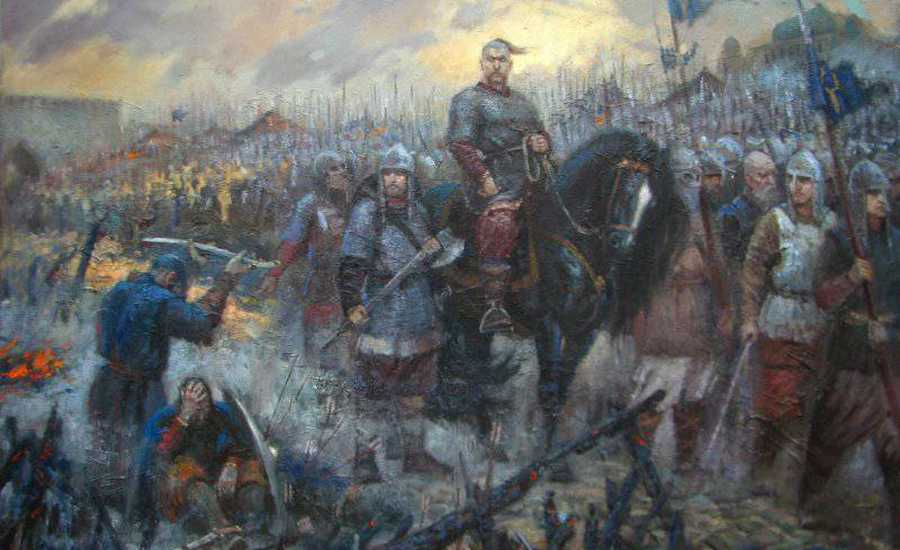
The ten years of Sviatoslav's rule of Kievian Russia, 962 to 972, have been called "the great adventure". Sviatoslav stands out in history as a classic warrior-prince: simple, severe, brave, sharing with his men uncounted hardships as well as continuous battles. In 964 Sviatoslav started out on a great eastern campaign. First he subjugated the East Slavic tribe of the Viatichi, who had continued to pay tribute to the Khazars rather than to Kiev. Next he descended to the mouth of the Oka River, bringing the surrounding Finnish tribes under his authority. From the mouth of the Oka he proceeded down the Volga, attacked the Volga Bulgars and destroyed their capital. His next step was war against the Khazar state, which had impressive results. The Russians smashed the Khazar army, captured and sacked the Khazar capital, Itil, and reached the Caspian Sea. Sviatoslav then defeated the Alans and some other peoples of the northern Caucasus. The prince returned to Kiev in 967. On having defeated the Volga Bulgars and the Khazars, Sviatoslav completed the unification of the East Slavs around Kiev. Also he brought under Russian control the great Volga-Caspian trade route, which had always been of peculiar importance.
In the following year, 969, Sviatoslav invaded the Balkans and even challenged the Byzantine Empire. The new emperor, the famous military leader John the Tzimisces, had become fully aware of the new danger. On having overwhelmed a rebellion in Asia, he shifted his main effort to the Balkans and finally defeated the Russians. Sviatoslav was forced to sign a peace treaty on the conditions that he abandoned the Balkans and promised not to challenge the Byzantine Empire again in the future. On his way home, with a small retinue, he was attacked and killed by Byzantium forces. According to the Primary Chronicle, the Pecheneg khan headman that killed Sviatoslav had a drinking cup made out of Sviatoslav's skull. The great adventure had come to its end.
Scholars have long debated about the role that Sviatoslav played in Russian history. Some claim that his policies contributed to the rise of Kievian Russia; others argue that no good things resulted from his numerous campaigns. The Russian historian Karamzin wrote: "Sviatoslav deserves the admiration of a poet and also the reproach of a historian." He's probably right.
Kiev at its Zenith
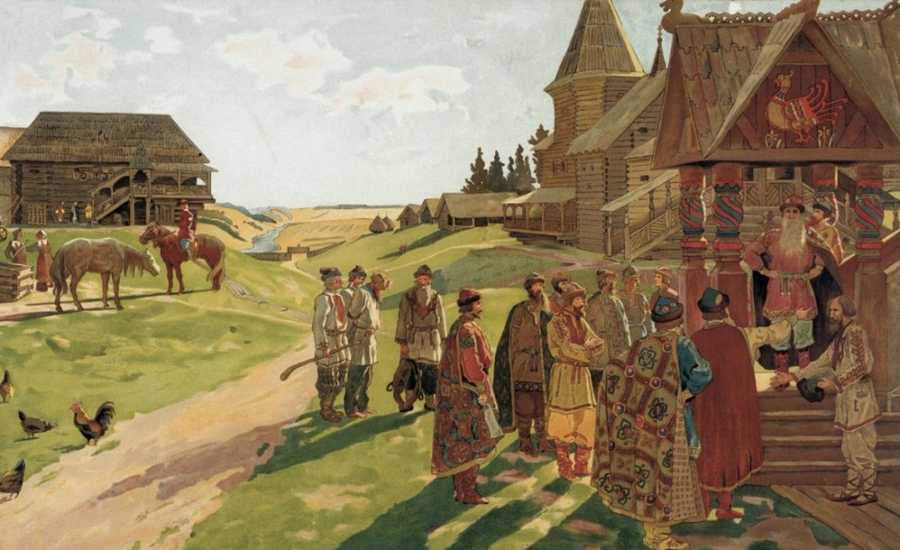
During his reign Sviatoslav, constantly away with the army, entrusted the administration of the Kievian area to his elder son Iaropolk, and dispatched his second son Oleg to govern the territory of the rebellious Drevliane. But inhabitants of Novgorod, the second largest town of Russia, were without a representative of the prince to rule over them. To correct this mistake they sent an ambassador to Sviatoslav to ask him for a governor. The Prince decided to appoint his third son Vladimir to this position. Although Vladimir was a bastard (his mother was a slave), the people of Novgorod accepted him as their ruler.
Following Sviatoslav's death, a civil war among the brothers broke lose. At first Iaropolk defeated Oleg's troops and killed his brother. Then he sent his representatives to manage Novgorod, and Vladimir had no other choice but to escape abroad to Sweden. For some time Iaropolk became the ruler of the whole of Kievian Russia, but his reign didn't last long. On having hired Varangian warriors, Vladimir returned to Novgorod and reestablished his rule over the town and the territory around it. He was determined to become the prince of Kievian Russia and to punish Iaropolk for his brother's death. He gathered a sufficient force and conquered the principality of Polotsk, where Iaropolk's friend, Varangian Rogvold, had been in power. Two of Rogvold's sons died, while his daughter Rogneda, who had rejected Vladimir's proposal earlier, agreed to marry him. Then Vladimir undertook a major campaign against Iaropolk. The latter soon had to surrender because one of his commanders, Blud, had betrayed him. Vladimir generously promised to forgive Iaropolk and guaranteed him an honorable position in the court. But Blud induced two Varangians to kill the ex-Prince. Although Vladimir punished the betrayer severely, he also became responsible for his brother's death. Thus the first civil war among the princes was marked with fratricide.
Prince Vladimir and Christianity
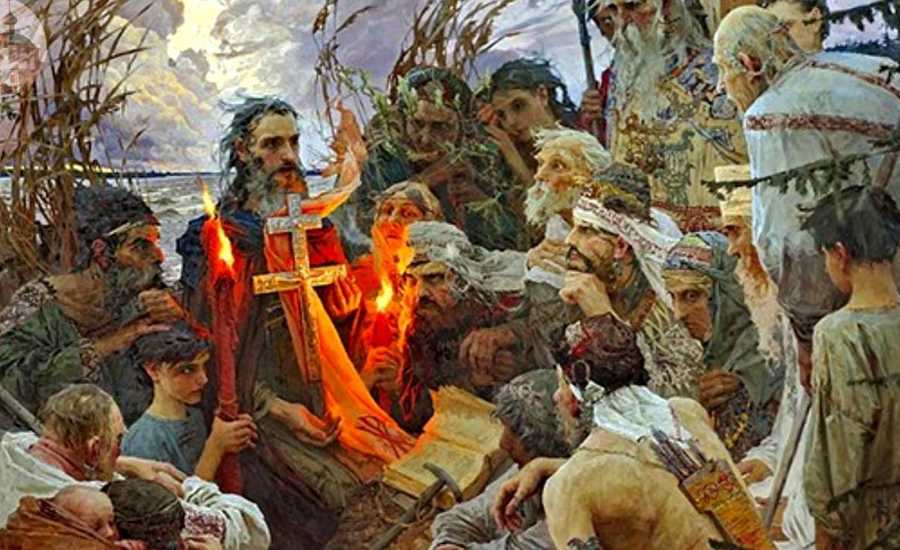
During Vladimir's reign (980-1015) Kievian Russia reached its height in many realms and became one of the strongest and culturally most developed countries in Europe. But in the first years of his rule Vladimir continued in large part the policies of his predecessors. Among the East Slavs, he reaffirmed the authority of the Kievian state which had been badly shaken during the years of civil war. He recovered Galican towns (situated in western Russia) from Poland, whose king had gained control over them in return for supporting Iaropolk. Vladimir also made a generally successful effort to contain the Byzantine ruler Pechenegs. He built fortresses and towns and brought settlers into the frontier districts. However, Vladimir's greatest fame rests on his relations with Byzantium and, most especially, in the adoption of Christianity, which was to change Russian history forever.
Vladimir actually demonstrated no interest in the teachings of Jesus Christ. He represented a typical pagan, having five wives and an incredible amount of concubines. In an attempt to strengthen his authority over the East Slavic areas, Vladimir decided to proclaim Kiev not only a political center, but also a religious one. With this aim he carried out the first religious reform in order to create one pantheon of pagan gods and thus unify the faiths of the population. In Kiev, on a hill not far from the prince's palace, wooden images of the most important gods were erected. These were the idols of Stribog, Choros, Simargle, and Mokosh, but that of Perun was the tallest and most beautiful of them all. Its head was made of silver, while the moustache of gold. This wasn't surprising, for Vladimir proclaimed Perun the supreme god of Kievian Russia, which should be worshiped by everyone. According to the Primary Chronicle, huge sacrifices were made by the bases of idols and sometimes they even included that of men.
However, the first religious reform had led to nothing, and there were some important reasons for this. It turned out to be a difficult task to consolidate the peoples of Kievian Russia on the basis of polytheism. Perun was mainly worshiped by the Prince and his retainers, while the rest population preferred other gods. That's why Vladimir decided to try adopting a monotheistic religion, for they offered a greater opportunity to consolidate his subjects spiritually. Among most influential of them at that time (as well as today) was Christianity, Islam, and Judaism, but it took the prince and his advisors some time to choose between them. According to the Primary Chronicle, in 986 the missionaries, representing all the monotheistic religions, came to Kiev to take part in the theological dispute in Vladimir's palest. They were a Bulgar of the Moslem faith, a rabbi from the Khazar state, a legate of the Pope, and a Greek philosopher from the Byzantine Empire. Every one of them tried to persuade Vladimir that their religion was best. The Philosopher's preaching turned out to be especially convincing. Vladimir was nearly persuaded to accept Christianity, but decided to wait for some time. Following the advice of his elders, he sent ambassadors to the neighboring countries to see which religion best suited Russia. When they came back to Kiev he listened attentively to each of them. Ambassadors didn't like Moslem services. The unquestionable advantage of this religion from Vladimir's point of view was that it allowed men to have more than one wife (as already mentioned, Vladimir already had five!). But on the other hand it absolutely prohibited alcohol. Taking into consideration the fact that "the drinking is the joy of the Russian" the prince decided to spurn Islam. Judaic services also produced no particular impression on Russian ambassadors. But they were fascinated by the Orthodox Christian services at which they had been fortunate to attend in the city of Constantinople. "We didn't understand whether we were on Heaven or on Earth. Never before have we seen such lordliness." This was a good argument in favor of Christianity.
Russia lied at cultural crossroads and had contacts not only with Christian countries, such as the Byzantine Empire and Bulgaria, but also with the Moslem state of the Volga Bulgars and other more distant Moslems to the southeast as well as with the Jewish Khazars. But the influence of Christianity overshadowed that of other monotheistic religions in large part because it had a longer and richer history in Kievian Russia. In fact, there may even have been a Russian diocese of the Byzantine church as early as 867. A Christian church of St. Ilea existed in Kiev in the reign of Igor, and many of whose retainers were Christians. Furthermore, the political crisis in the Byzantine Empire offered excellent opportunities to adopt Christianity and to keep the country's political independence.
A crucial point in Russia's adoption of Christianity came when one of the military leaders, Varda Phocas, started an uprising intending to seize power in Byzantium. He managed to conquer all of Little Asia and even threatened Constantinople. In this situation emperor Basil II had no other choice but ask Vladimir for help. Vladimir agreed to send about 6000 warriors to Constantinople but in return demanded to let him marry Basil's sister Ann. Thanks to Russian troops the uprising was overwhelmed, but the emperor wasn't in a hurry to keep his promise. On having felt deceived, Vladimir besieged and captured the Byzantine outpost of Chersones in Crimea. Basil was forced to send his sister to Kiev, and Vladimir promised to convert himself to Christianity.
The precise date of the "baptism of Russia" is rather controversial. Some historians claim that this event took place in 988, while others prefer the year 990. Nevertheless, on having returned from Chersones to Kiev in or around 988, Vladimir ordered the destruction of all the idols standing near his palace. Then he invited the inhabitants of Kiev to come to the river and take part in the rite of christening, which was to be conducted by Byzantine priests. Much to his surprise they came rather willingly. The inhabitants of other Russian cities were also baptized, but with more of a struggle - people ran away to the forests, others attacked the priests and killed them, some of them even fought against the prince's troops. Clearly not all of Russians were ready to forget about Paganism and to adopt Christianity. But we should also keep in mind that Christianity in Russia wasn't accompanied by such cruelties such as those inflicted on Lithuanian tribes or on the Amerindians in the 16th century. Most of the population showed an interest in the teachings of Jesus Christ and adopted the new religion willingly. It took Russia just a century to adopt the new religion, while in Norway and in Sweden it took 200-250 years.
The Consequences of Religious Reform

The second religious reform led to at least three political consequences. First, it resulted in the strengthening of the Kievian princes' authority over their lands. The Prince was proclaimed a sacred person by the Church, and this enabled him to be easily recognized by all the neophytes of the country. Secondly, the reform made Kiev not only a political, but also a religious center of Russia, which was of vital importance in the Middle Ages. Thirdly, Kievian Russia was finally acknowledged on the world scene, which put an end to its international isolation. In the Middle Ages it was difficult for a Pagan state to influence world policy.
On having adopted Christianity, Prince Vladimir made Russia an essential part of the Christian world, which certainly contributed a lot to its rapprochement with Western countries. But still, there is one aspect of Vladimir's innovation that we should always take into consideration. The point is that Christianity came to Russia from Byzantium and not from Rome. Although at the time this distinction didn't have its later significance: the break between the Eastern and the Western Churches occurred only in 1054. After that the Russian allegiance to Byzantium determined many aspects of the country's subsequent history. It meant that Russia stayed outside the Roman Catholic Church, and this in turn not only deprived Russia of that which Church itself had to offer, but also contributed in a major way to the relative isolation of Russia from the rest of Europe and its Latin civilization. Significantly, it helped to inspire Russian suspicions of the West and the tragic hostility between the Russians and the Poles.
On the other hand one can well argue that Vladimir's turn to Constantinople represented the richest and the most rewarding spiritual, cultural, and political choice that he could have made at the time. The absence of Latinism and the emphasis on local languages had its advantage. It brought religion, in the form of readily understandable Slavic rite, close to the people and gave a powerful impetus to the development of a national culture. To sum up, Orthodox Christianity laid a spiritual foundation for the development of a distinct Russian civilization, determining different realms of its life. The religion plays a large role even today, in post-Soviet Russia.
As we can see, the Vladimir's role in the country's history can be compared with that of Peter the Great's by the lasting consequences of his reforms. In addition to being remembered as a mighty and successful ruler, Vladimir was canonized by the Church as the baptizer of the Russians, "equal to the apostles". Christianity not only influenced his policy, but also changed him as a person. The teaching of Jesus Christ made a kind, caring, mild and humane man out of an aggressive, warlike and libidinous barbarian. Vladimir even dreamt of abolishing capital punishment, because he was afraid of being accused by God of numerous murders.
Vladimir's death in 1014 was followed by another civil war, which lasted four years. Several of Vladimir's sons, who had served in different parts of the realm as their father's lieutenants, became involved in the struggle. According to the Primary Chronicle, the eldest of them all, Sviatopolk, intended to become the only ruler of the country. At first he assassinated his brothers Boris and Gleb, Vladimir's sons by Ann. Boris and Gleb offered no resistance, preferring death to struggle for power. They acted in accordance with Christian religious ideal, and therefore were proclaimed the saints by the Church later in the century. On having killed Boris and Gleb, Sviatopolk undertook a major campaign against Sviatoslav, who was in charge of the lands of the Drevliane. The only brother who was still in power was Iaroslav, who had been sent by Vladimir to manage Novgorod. But despite strong Polish aid, in 1019 Sviatopolk was defeated by Iaroslav, who had managed to hire enormous Varangian troops.
Prince Iaroslav
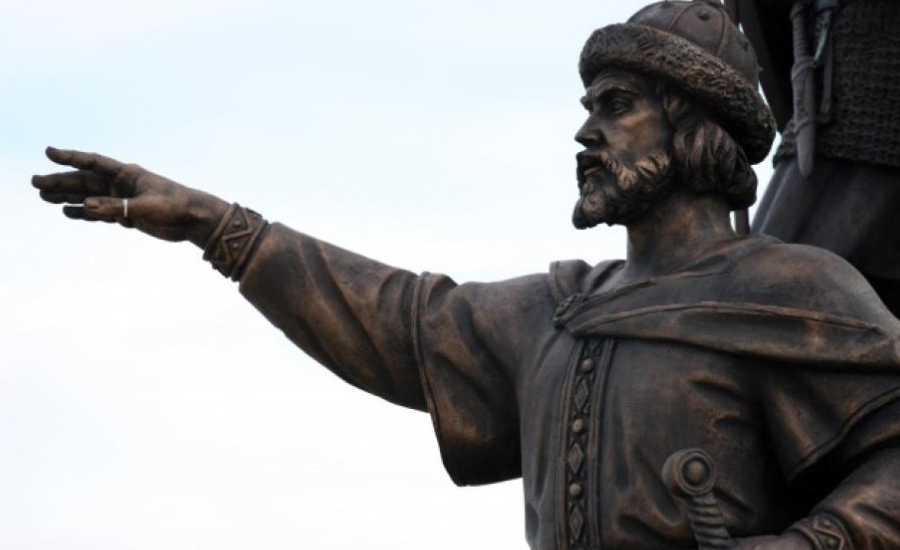
Prince Iaroslav, known in history as Iaroslav the Wise, ruled in Kiev from 1019 until his death in 1054. Hs reign has been generally acclaimed as the high point of Kievian development and success. Yet, especially in its first part, it wasn't free of danger, and the prince and his subjects had to work as hard as their predecessors had. Civil war didn't actually end with Iaroslav's occupation of Kiev. He had to fight against his brother, Mstislav of Tmutorokan (Tmutorokan was a principality situated near the Sea of Azov). In 1026 they finally decided to divide the realm, allowing Mstislav to govern the territory east of the Dniepr, while Iaroslav took charge of the areas west of it. This was the case until Mstislav's death in 1036, after which Iaroslav became the ruler of the entire Kievian state. Besides fighting for his throne, he also had to conquer numerous rebellions, ranging from a militant pagan revival near Suzdal to the uprisings of various Finnish and Lithuanian tribes.
When speaking about Iaroslav's foreign wars, we should first name his successful campaign against Poland, which resulted in a gain of some Russian lands in the southwest in return for supporting Sviatopolk. In 1046 Iaroslav tried to fight against Byzantium, but this attempt failed. But still, a rather profitable peace treaty was signed after it, and relations between the two states started to change for the better. The 1046 campaign proved to be the last in the sequence of Russian military undertakings against the mighty Byzantine Empire.
Of special importance were Iaroslav's wars against the Pechenegs. In 1037 he defeated them so badly that no recovery was possible for them afterwards. This event led to a quarter-century of relative peace on the steppe frontier, until the arrival from the east of new nomads, the Polovtsy.
During Iaroslav's rule, the prestige of the Kievian state stood at its zenith. The state itself stretched from the Baltic to the Black sea and from the mouth of the Oka River to the Carpathian Mountains. The Kievian ruling family enjoyed close connections with many other reigning houses of Europe. Iaroslav obtained the hands of three European princesses for three of his sons; one of his sisters became the wife of the Polish king, another wife of a Byzantine princess. He married his three daughters to the kings of Hungary, Norway, and France. Iaroslav's daughter Ann gave her royal oath, using not Latin, but the Slavic Bible, especially brought to her from Kiev. Strange though it may seem, this Bible stayed in the Cathedral of Reims, where French kings and queens were being crowned and all of them used it for this important ceremony.
Iaroslav's great fame, however, rests more on his actions at home rather than on his activities in foreign relations. His name stands connected with an impressive religious revival, and with Kievian law, education, architecture and art.
Since the adoption of Christianity, the Church had been very much dependent on Byzantium, which sent Greek hierarchs to manage Russian dioceses. But Iaroslav dared to appoint Russian bishops and the religious thinker Hilarione for the position of metropolitan. This however, didn't spoil relations with Constantinople. At this time the first Russian saints appeared, which contributed much to the spread of Christianity over the population. They were princes Boris and Gleb, who had died martyr's deaths during the civil war of 1015-1019.
Iaroslav played a significant role in Kievian culture by such measures as his patronage of artists and the establishment of a large school and a library in Kiev. In the library, books on theology, history and literature were translated from Greek into Russian. This acquainted the population with the latest achievements of the highly- developed Byzantine culture. It was during the rule of Iaroslav that the first Russian metropolitan had written his famous theological and historical work, "On Law and Grace." This fact testified that cultural innovations, conducted and supported by Vladimir and Iaroslav, started bearing fruit. The Prince himself was known as a great reader, who used to fall asleep with a book in his hand. Apparently this was one of the reasons why Iaroslav was called the Iaroslav the Wise by his subjects.
Iaroslav the Wise was also responsible for the first Russian legal code, The Russian Justice. The Russian Justice testifies to a high level of development of Russian juridical culture. For example, corporal punishments and blood feuds were officially abolished, and although capital punishment did exist, fines of different kinds were preferred.
Generally speaking, at the time of Vladimir and Iaroslav the power and prestige of the Kievian Russian state stood at its peak. We can say, without exaggeration, that economically, politically, and culturally the country was developed to a higher extent than elsewhere in Europe, with a single exception being the Byzantine Empire. Vladimir and Iaroslav are rightly considered some of the best rulers in Russian history.
Decline
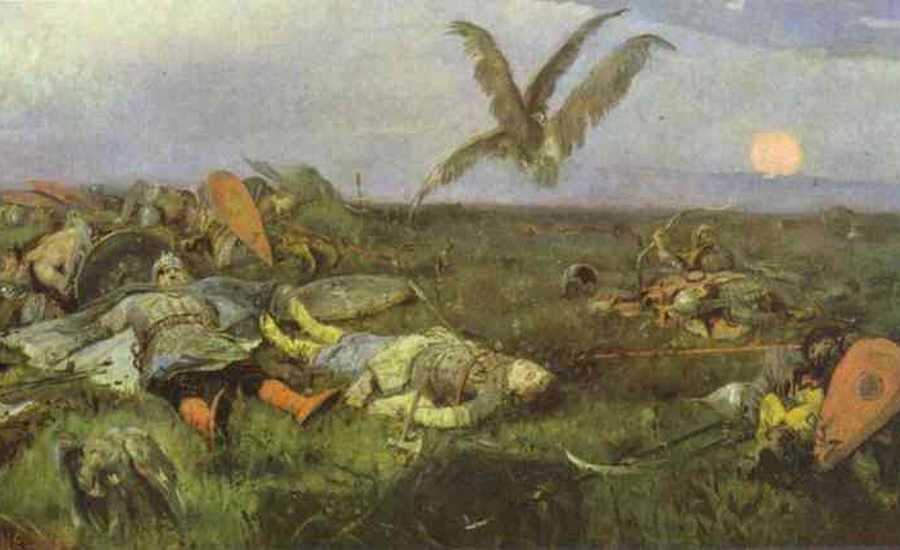
Before his death Iaroslav assigned separate princedoms to his sons: Iziaslav, the eldest, received the Kiev and Novgorod areas; Sviatoslav, the second, the area centered on Chernigov; Vsevolod, the third, Pereiaslavl; Viacheslav, the fourth, Smolensk; and Igor, the fifth, Vladimir-in-Volynia - always with their surrounding territories. Iaroslav knew well what civil war was and, intending to prevent such in the future, divided the lands between the brothers so that the possessions of each of them were situated in different parts of the country. The princes were expected to co-operate and to hold Kievian Russia together. For the first twenty years they did cope with this task rather successfully, but then the system - if indeed it can be called a system - began to collapse. Iaroslav's arrangement worked to break the natural links between a prince and his state, and it excluded sons from succession in favor of their uncles, their late father's brothers. Besides, with a constant increase in the number of princes, precise calculation of appropriate appointments became extremely difficult. At their meeting in the town of Liubech in 1097 the princes agreed that the practice of succession from father to son should prevail. Yet the principle of rotation from brother to brother remained linked for a long time to the most important seat of all, that of the Grand Prince in Kiev.
The reigns of Iziaslav, Sviatoslav, and Vsevolod, the last of whom died in 1093, as well as that of Iziaslav's son Sviatopolk, who succeeded Vsevolod and ruled until his death in 1113, presented a frightening record of constant civil wars. They started to fight against each other for the position of the Grand Prince in Kiev. At the same time the country had to face a new major enemy, the Polovtsy, or the Cumans as they were known in the West. This latest wave of Turkic invaders from Asia had defeated the Pechenegs, and had gained control over the steppe in the southeastern frontier. They attacked Kievian territory for the first time in 1061, and after that became a persistent threat to the security and even existence of Kievian Russia.
Nevertheless, the Kievian state had one more revival under the outstanding rule of Vladimir Monomakh. Son of the Grand Prince Vsevolod, he became prominent in the political life of the country long before he assumed high authority. He and his father managed many local principalities, took part in civil wars and participated in princely conferences, trying to persuade his "colleagues" to come together for a mutual campaign against the Polovtsy. Also, he played a significant role in the actual fighting against the nomads, obtaining the greatest victory over them in 1111 at Salnitsa. After this event he was invited to the Kievian seat by the inhabitants of the town. Being in power from 1113 until his death in 1125, Vladimir Monomakh spent most of his time in exhausting campaigns. He waged war in Livonia, Finland, the land of the Volga Bulgars, and the Danubian area, driving away the Poles and the Hungarians among others. Vladimir undertook 83 major campaigns against the Polovtsy and killed 200 Polovetsian princesses; according to tradition, Polovetsian mothers used his name to scare their children. The prince was famous not only for his numerous military undertakings, but also for his actions at home. As a lawgiver he issued some vitally important laws, which were to supplement the Russian Justice, which, as we know, had emerged during the reign of his grandfather Iaroslav the Wise. The 11th century saw a blossoming of the arts, in particular literature. It was at this time that the Primary Chronicle, our main source on early Russian history, was written.
Vladimir Monomakh was succeeded by his able and energetic son Mstislav (ruled 1125-1132) and after him by another son, Iaropolk, who reigned until his death in 1139. But before long the Kievian seat became again the object of bitter contention and civil war, which often followed the classic Kievian pattern of struggle between uncles and nephews. In 1169 one of the contenders, Prince Andrew, or Andrei Bogoliubskii, of the northeastern principalities of Rostov and Suzdal, not only stormed and sacked Kiev but, after his victory in the civil war, transferred the capital to his favorite city of Vladimir. Andrew Bogoliubskii's action both represented the personal preference of the new grand prince and reflected a striking decline in the importance of the city on the Dniepr. Kiev was sacked again in 1203. Finally it suffered virtually complete destruction in 1240 at the hands of the Mongols.
Read on to learn about the Mongol Invasion.
